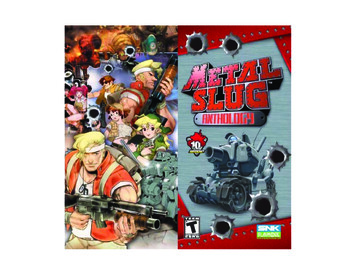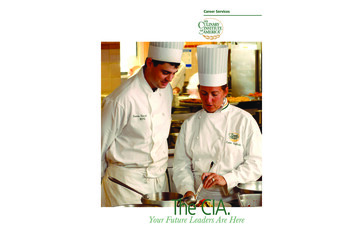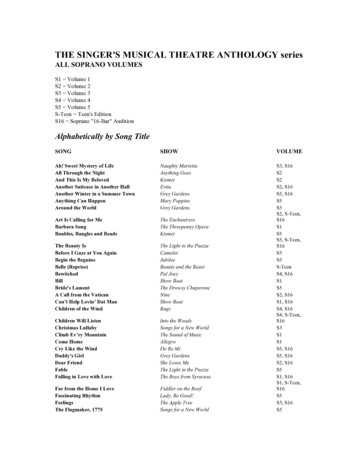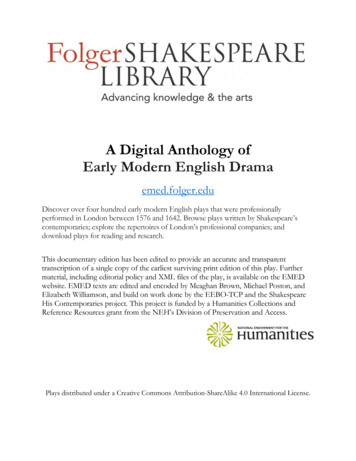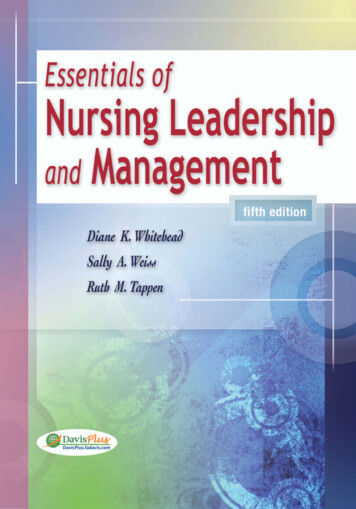
Transcription
Angelou’s Autobiographical Anthology:An Artistic Manifestation of an Authentic VoiceAné Nyoka Ebie-MoutonAlexander Hamilton Middle SchoolAutobiography immortalizes a person. Ané MoutonINTRODUCTIONMaya Angelou is a universal author whose autobiographical series encompasses all thecharacteristics of what distinguishes a literary work. Angelou‘s work also demonstrates theeffective use of the literary techniques that contribute to the beautifully poetic voice in herliterature. I believe that an intense interaction with I Know Why the Caged Bird Sings, her first ofsix autobiographical volumes, will give invaluable insight of how the masterful manipulation ofliterary techniques helps to create the distinctive voice that characterizes the genre. Since theperspective, form, structure, and voice are consistent throughout her autobiographical series, mystudents can have uninhibited access to Angelou‘s very soul.I plan to use Angelou’s first and most renowned I Know Why the Caged Bird Sings to explorethe elements that come together to color the literature of the autobiographical genre. I also planto use this work as a model for creative writing. Research shows that when students are able toidentify literary elements in literature, it encourages them to embellish their own writing byexperimenting with the execution of these elements. Ideally, my holistic goal is to use Angelou’sautobiographical series to empower my students to engross themselves into the mosaic ofAngelou’s life through literature and recognize a distinctive voice through the vehicle of thewritten word, and understand how Angelou’s multi-thematic autobiographical series makes heruniversal experience that which pertains to being distinctly human, encompassing yettranscending the classification of the minority-majority Black, female: one of challenge andtriumph!I believe that the vehicle by which these goals will be actualized for my students will bethrough in-depth exploration of the elements that inundate and color this literature. We will alsoexamine how Angelou transcends conventional autobiographical structure to give us more than astory, but to give us an experience.What Will I Teach?My initial goal was to use all the books from Angelou‘s autobiographical series to educatemy students on how the effective manipulation of literary devices results in literary masterpieces.After much thought and consideration however, my experience as a novice Vanguard Readingteacher has informed my perspective by emphasizing the importance of focusing on the depth andcomplexity of fewer concepts for the purpose of mastery, versus trying the cover many conceptswith time prohibiting in-depth exploration. Depth and Complexity is an educational frameworkspecifically geared for the Gifted and Talented whose mechanics will be explored as a strategicframework by which I will equip my students to approach reading as an art.Ané Nyoka Ebie-Mouton57
Moreover, my newly informed paradigm shift has led to the decision to focus on Angelou‘sfirst and most popular autobiographical work, I Know Why the Caged Bird Sings. Furthermore,this insight has influenced the decision to focus in-depth analysis on the effective application of afew literary devices instead of briefly visiting as many as possible. This unit can then serve as afoundational model by which other teachers can build a repertoire of literary devices, revealing itseffective application across various literary genres.I believe that I Know Why the Caged Bird Sings is best for sixth graders because it chroniclesAngelou‘s life experiences from the ages six to fifteen, forming part one of the six-part series.Each subsequent book corresponds with age progression and more mature life experiences thatmay not be appropriate for them to have exposure to. Setting a clear and concise structure for thebook will lay the foundation for teaching the rest of the works in Angelou‘s autobiographicalseries, which, I hope through proper vertical alignment and collaboration will follow my studentsto the conclusion of their tenure in secondary school.Why Is It Important to Teach this Topic?It is important to teach the effective application of literary devices in literature because itcolors text, facilitates comprehension, and invites students to recognize reading as an art whilehelping them learn most effectively by example. If students have clear tangible models, they canuse them as stepping-stones by which they can effectively analyze and synthesize literature,ultimately producing their own work. I want my students to develop an intimacy with theliterature, recognizing the effective use of literary devices as the paint that must be blended intotints and hues to form the masterpiece. Furthermore, as we are to interpret art with various factorsin mind, I want my students, seeing literature as art, to do the same, becoming so comfortablewith it that they take audacious risks, imposing their perspective where they feel there is anabsence of such by the speaker in (narrator) or of (author) the work. Pulitzer Prize winning authorToni Morrison models this in her envisionment of Toni Cade Bambara‘s Those Bones Are Not MyChild. From the following excerpt:Your ears strain, stretching down the block, searching through schoolchild chatter for thatone voice that will give you ease. Your eyes sting with the effort to see over bushes, lookthrough buildings, cut through everything that separates you from your child‘s startingpoint---the junior high school.Morrison envisions the following:I see a woman-no, invent her: from fingers clinched on a broomstick to the sandals I amsure she is wearing. Flip-flops, maybe. She wears a skirt-not jeans. The porch is oldcement with crevices and cracks where soil gathers and fall wind is always blowingleaves she can‘t get them out; they‘re stuck like she is. The street is tree lined, houseshedged, brick ones, pale clapboard with wide yards. A hose is curdled on yellowinggrass. A pair of skates that should have been put away? Or a bicycle? The silence is nottotal--there is traffic beyond, birds--but it is nevertheless disturbing because the singlevoice needed to calm me is not there. I know that fear. Even when I‘m told there is noreason for it. Especially then (175)Morrison takes artistic license to invent the woman with the use of her imagination. She goeson to deal with the irreparably cracked sidewalks as a metaphor for the protagonist‘s stagnation.She even creates the sounds that may be heard in the setting, grounded in the textual evidence ofthe time and place of the event in question. None of this envisionment is explicitly stated in thetext; Morrison just brought her imagination to the literature and let it run wild.The wonderful thing about the interpretation of literature is the mandate that kids validatetheir interpretation through the text. This stipulation will help facilitate comprehension, the58Houston Teachers Institute
sharing of various text perspectives that will inform and inspire minds in a corporate learningenvironment. Wouldn‘t it be amazing if our children had the paradigm that words on the page areonly half of it, but an essential piece to a full and efficacious understanding of the literature iscontingent on the literature based artistic license they bring to the table? Just imagine how muchtheir comprehension would be enhanced! Just imagine the impassioned stake they would have inreading if there were a legitimate and sincere forum in which their thoughts were encouraged,lauded, and placed on an academically artistic pedestal? Once students recognize the importanceof their role as artists in contributing to and getting the most out of the literature, they will thenbecome empowered to use their writing as a vehicle to paint the ideas that will authenticate andimmortalize their own voices.As a reading teacher working in conjunction with a writing teacher, it is my responsibility toexpose students to the way literary elements function to authenticate the narrative voice in theautobiographical genre. Ideally, this exposure should inspire the production of works that reflectthe use of these elements as they partake in the process of establishing their own voices throughwritten composition.How Will I Teach It? Teaching through the Paradigm of Depth and ComplexityThe strategies I will use to equip my students to perform in-depth analysis of Angelou‘s workare inspired by the Depth and Complexity conceptual framework. If my students are to becomeartists to see Angelou‘s work through an artistic lens, they must be given the tools to change theirthinking. Depth and Complexity icon cards are learning tools that serve multiple purposes. Eachicon card introduces a different concept, and any course of study can be viewed through the lensof any or all of the concepts. The icon cards provide task starters to prompt student thinking, theyidentify related thinking skills that cultivate higher-order conceptual development, inspired by theBloom‘s Taxonomy framework. The cards also provide a sample list of where the given conceptcan be imbedded and introduced across all core content areas. I will briefly introduce eachconcept, and then share a few strategies to implement this unit of study grounded in each depthand complexity conceptual model.The conceptual models that make up depth and complexity are Language of the Discipline,Details, Patterns, Rules, Trends, Unanswered Questions, Ethics, Big Ideas, Relate over Time,Multiple Perspectives, and Across Disciplines. It is ill-advised to explore all eleven concepts inone unit, but to use perhaps one or two per unit. I will, however, for the purpose of thiscurriculum unit blueprint, briefly visit them all to cultivate ideas about how they might be used byother educators.Language of the DisciplineLanguage of the Discipline is represented by a lips icon, which communicates that we will bedealing with language. This concept refers to terminology, nomenclature, lexicon, tools of thediscipline, combinations and patterns of terms, jargon, idiom, signs and symbols, figures ofspeech, eponyms and neologisms of the discipline (Gould).One task starter I might implement in relation to our interactive analysis of Angelou‘s I KnowWhy the Caged Bird Sings will be the open-ended question, ―What words and phrases are specificto the work in this unit?‖ My expectation is that they will share responses like, autobiography,alliteration, allusion, figurative language, simile, metaphor, and identity crisis. I will then getthem to perform a related thinking skill, such as identifying the relationships among these terms.A response might be that they all have to do with literature, and that the autobiography houses thefigurative language, which is created by the manipulation of the literary techniques alliteration,simile, and the like. I might group the students cooperatively and ask them to identify all wordsthat are being used non-traditionally to modify nouns. I would then ask them to identify whatAné Nyoka Ebie-Mouton59
makes them non-traditional. One response I would expect is that they are not all adjectives, orthat there are many word groupings, such as ―old lady long‖ (Angelou 8), in young Angelou‘sdescription of the Easter dress that was a ―plain ugly cut-down from a white woman‘s once-waspurple throwaway‖ (Angelou 8). We might then go on to examine these non-traditional nounmodifiers to make discoveries about Angelou‘s writing style, how it facilitates envisionment, andwhat we can take from it to inspire our own writing. We will also use this concept to facilitatecomprehension by exploring plot and theme.DetailsA flower icon, communicating that ideas much like flowers, have intricate details thatdistinguish them, represents the Details concept. This concept refers to clues, facts, features, data,ideas, traits, items, parts, particulars, specifics, elements, factors, and attributes (Gould).A task starter for my unit under this conceptual frame might be the question, what featurescharacterize the autobiographical genre? Some responses I would look for are that they aretypically chapter books whose content reveals the life events of a person. The author is the personwho is writing the book about himself. I might ask kids to then cooperatively select details of lifeevents that have various levels of bias, emphasizing that all autobiographical texts are writtenwith some level of bias, and ask them what in the text suggests that there is overt (or covert)degrees of bias. I might also go deeper and ask them how Angelou‘s stylistic command of the texteclipses the bias if we are not reading with an artistic eye. This concept also sets the stage for indepth character analysis.PatternsThe Patterns icon is represented by circles strategically placed in the pattern of a letter Z.Patterns are predictive, able to be replicated, cycles, motifs, repetitive, made up in details, personmade and natural designs, and recurring elements (Gould).A conceptual task starter for this unit might be to describe the motifs (recurring themes)found in the book and compare and contrast them. One answer might be shame. Some motifs ofshame are reflected in young Maya‘s shame in standing up before the church to do her Easterspeech. Another instance of shame is in her appearance. Not just shame in what she is wearing onEaster Sunday, but shame in the skin she is in. There is also the shame associated with hermolestation by her mother‘s boyfriend, resulting in her prolonged silence. I may cultivate therelated thinking skill of cause and effect by asking the students to identify the events that lead upto the shameful experience, and identify the degrees of or similarities and differences between theevents that lead to the shameful experiences. Some other patterns I will have them flesh out arethat of plot, conflict, writing style, and characters.RulesA chart, reflecting order, represents the Rules conceptual framework. Rules are characterizedby standards, related to structure, authoritative directions for conduct or procedure, usual coursesof action or behavior, statements of truth (all or most of the time) methods, and organizationalelements (Gould).A conceptual task starter for this unit may be determining the standards thatuncompromisingly determine whether a work of literature is autobiographical, which will lead usto the rules that govern the distinctiveness of literary genres. A related thinking skill might be todifferentiate facts from opinions in Angelou‘s work with textual evidence. Another might be toclassify Angelou‘s relationships with all the people with whom she has any form of interaction.This particular analysis will lead them to discover that relationships are not all positive orpersonal, and often dichotomous, one gaining its significance from the subjugation of another: for60Houston Teachers Institute
instance, Angelou‘s relationship with her molester was that of victim/culprit. There cannot be avictim without a culprit; the implications of ―whiteness‖ have no meaning without the―otherness‖ associated with blackness. That‘s the rule! Other skills I would teach might deal withrules governing grammar and punctuation and how Angelou uses her artistic license to breakgrammatical rules in order to reinforce the authenticity of her literary voice.TrendsA chart reflecting progress over time represents the Trends conceptual framework. Trendscome in the form of general directions, tendencies, current styles, drifts, influences, and changesover time (Gould).A task starter for my unit of study may require students to describe the trends in Angelou‘sprose chapter books. This question would require me to introduce and establish a familiarityamong my students with the subsequent volumes that make up Angelou‘s autobiographical work.After this introduction, I would expect the students to identify trends such as that eachautobiographical work is about a different season of Angelou‘s life, focusing on her progressionin age and subsequent life experiences. Another might be the trend in her career choices, all ofwhich were non-traditional. Her many professions included: prostitute, madam, Broadwayperformer, and, of course, poet and author. Another trend was that she accomplished a lot of―firsts.‖ Gather Together in My Name, Angelou‘s second autobiographical volume, reveals heraccomplishment as the first African-American female conductor of the San Francisco Trolley(Angelou 356). And Angelou‘s third autobiographical volume, entitled Singin’ and Swingin’ andGetting’ Merry like Christmas, reveals that she was one of the original cast members of GeorgeGershwin‘s Porgy ‘n Bess, the first opera performed by an all African American cast (Angelou631).Some related thinking skills I might teach might be to identify the relationships among thetrends in Angelou‘s very diverse professions. Some questions that might incite revelation maycenter around what is the same and different about her professions, how she acquired them, theinfluences they had in her life, and the direction in which they took her life. Further explorationof this might be in the context of the way this concept operates in historical fiction, nonfiction,character types, spelling, punctuation, word usage, and favorite authors and genres.Unanswered QuestionsThe Unanswered Questions concept is represented by three question marks, communicatingthat the work should be so dynamic that it inspires a substantial vestment that necessitates furtherinquiry for increased efficacy. Envisionment in Angelou‘s work will incite inquiry that the texthas not addressed, leaving it up to the reader to research answers based on what the text hasgiven, coupled with perspectives from life experiences. An unanswered question may come in theform of a puzzle, a conundrum, and unsolved problem or mystery, something unexplained, adilemma, or a situation that leaves one doubtful or uncertain (Gould).A task starter for my unit may be for my students to describe the unknown details or stimulifor how Angelou acquired the hand-me down purple dress her grandmother modified and madeher wear for Easter. Another question might center around the circumstances that prohibitedAngelou from wearing a new dress and whether the other kids at church had on new or modifiedEaster clothing. Another avenue of exploration is the point at which young Angelou discoveredthe dress was in fact a hand-me-down, as it seemed like she was unaware until the cruel in-themoment reality of her making the Easter speech. Was her vivid imagination of a Cinderella dressa reflection of her denial of the reality of the worn, used dress just as it was of the reality of herinescapable blackness?Ané Nyoka Ebie-Mouton61
To relate this idea to Bloom‘s Taxonomy thinking skills, I have my students prove theconclusions they have drawn from their questions the text fails to explicitly answer from thetextual evidence that helps them infer and envision, filling in the blanks. Other places in whichthis conceptual framework may be beneficial is in examining anonymous authors, pen names,author‘s message, author‘s motivation, personal likes and dislikes as the artist, and charactertypes.EthicsThe Ethics conceptual framework features a diamond, half of which is painted black, theother half, white. I believe this icon represents the differentiation between right and wrong. Ethicsare, or can be found in controversies, dilemmas, biases, prejudices, decision-making, principles of―right‖ behavior, a set or theory of moral values, philosophies and metaphysics, professional rulesor standards, and value-laden ideas (Gould).A task starter for my unit might be for students to describe ethical issues that arise in thedirect and indirect conflicts Angelou experiences with various characters in the book. I mightexpect a response to be the ethical issues of socialized perceptions of human worth, with Americabeing founded and built by basing the value of people by the color of their skin to perpetuate theirsubjugation. This ethical issue comes from an incident in the text where ―powhitetrash‖ (Angelou112) kids would come over by Angelou‘s grandmother‘s house and taunt them, disrespecting hergrandmother by urinating on their property, defacing it, and calling them names. Young Angeloucould not understand why her grandmother would allow this to happen, the children calling herby her first name, the grandmother calling them ―Ms/Mr.‖ and then their first name, and how shewould simply allow the children to have their way with the property in her presence, wait forthem to leave, and simply clean it up, humming the entire time. Angelou had to learn hard lessonsof survival during a time that this kind of unethical behavior was licensed.A related thinking skill might be for the students to distinguish fact from opinion when itcomes to the aforementioned conflict that produced the conversation about the ethics of humanworth. It is important for the kids to understand that societal opinions of human worth, oftencloaked in the factual guise of government mandates, have ethical implications that have cursedAmerican society since its inception. I would throw this question out to them: Is it a fact oropinion that one human being is more valuable than another? What are the circumstances underwhich one might feel compelled to determine this? Other places ethics might be found in theEnglish Language Arts/Reading content areas are plot dilemmas, conflicts, controversies, patternsof good vs. ―bad‖ characters, plagiarism, and media such as editorials, political cartoons, andpropagandistic articles.Big IdeaThe Big Idea conceptual framework, represented by a triangle supported by pillars, reflectsthat big ideas are umbrellas that cover and incorporate smaller, more marginal ideas. Big ideascan be found in generalizations, are related to many instances, developed from many facts,overarching, related to global or universal themes, and principles laws, and theories.I would have students apply related thinking skills in this unit by inferring a big idea fromsupporting evidence or information. For instance, one big idea that can be supported by evidenceis that of instability. Angelou had a lot of instability in her life, from being sent to live with hergrandmother, going back to live with her mother after the passing of her grandmother, her motherand father‘s wavering presence in her life, homelessness after having borne her first and onlychild as a teenager and much more. Other places big ideas can be inherent are literary themes,implicit and explicit content, poetry, conflict, and critical analysis, or, the term I have adoptedfrom Toni Morrison, reading as art!62Houston Teachers Institute
Relate Over TimeThe Relate Over Time conceptual frame is represented by an icon illustrating a continuouscycle of the past, present, and future. I believe this icon reflects how the same issues change orremain the same over time. Relating over time can mean looking at the past, present, and future,applying something historic to present knowledge, predicting something based on presentknowledge, applying from the past to the present, and noting change (Gould).A task starter I might use would be for students to identify multiple instances in Angelou‘swork that illustrate a significant difference in race relations from those of our current time. Imight then get them to identify how her stories of race relations change over the course of her sixpart series, which is about forty years. I may even have them explain it in the specific context ofthe professional opportunities she has had throughout the series. Other ways to facilitate studentrecognition of how change occurs over time might be through an examination of setting,historical relevance, historical authenticity, science fiction, biographies, historical fiction, and thetime setting of nonfiction writing.Multiple PerspectivesThe Multiple Perspectives conceptual framework is represented by eyeglasses, symbolizingthat there is always another side to every story. Multiple perspectives are communicated asdifferent points of view, ways of seeing and reporting things, are often dependent on time andplace, different slants on the same thing, and are affected by roles and responsibilities.A task starter to this unit might be to group students by their various perspectives on anethical issue that comes up in Angelou‘s work, and have them share what their perspective is andwhy. Going back to the event of the white children loitering on Angelou‘s grandmother‘s land, itmight be a good idea to group students by the point of view of who‘s response they felt was thebest overall response, her grandmother‘s conservative safe one, or Angelou‘s upset radical one,and why. Some students may even come up with a different point of view, and our grand, wholeclass conversational forum would accommodate this. Ultimately, this exercise will create a forumin which student ideas are informed and perhaps transformed by the insights of their peers. Imight have students judge the validity or credibility of their peers‘ various perspectives based onthe extent to which they probed, interacted with, and applied empathy in the text to support theirperspective. Other places multiple perspectives can be shared are in characterization, views of―good‖ and ―bad‖ characters, nonfiction points of view, persuasive writing, and editorials.Across DisciplinesThe Across Disciplines conceptual framework is represented by various shapes overlapping,illustrating the idea that interdisciplinary collaboration between various content areas provide thatmuch more student insight and real world meaning. Across disciplines could meanmultidisciplinary, interdisciplinary, establishes connections among disciplines, and touches onmany subjects at once.A task starter that I might implement in relation to this unit would be to ask the students how―across disciplines‖ is related to ―multiple perspectives.‖ I might then have my students do a roleplay focusing on our ethical issue of socialized perspectives of human worth. I might have eachof them be a minister, politician, mother, teacher, philanthropist, scientist, doctor and the like, andget each of their perspectives on this ethical issue. Because these professions also reflect variouscontent areas we can explore how one issue might be viewed or examined from a completelydifferent perspective based on various ways of thinking that come with each content area. Torelate them to higher order thinking skills, I would have the role players describe the topic in thecontext of their distinct discipline, and then have the students compare and contrast thisinformation. Other places within the English Language Arts/Reading discipline that thisAné Nyoka Ebie-Mouton63
conceptual framework could be applied are biographies, journals, diaries, letters, writing relatedto the discipline, and reading within the discipline.Examining Angelou‘s I Know Why the Caged Bird Sings through the Depth and Complexityconceptual framework paradigm will open up the world of the autobiographical genre in waysunimaginable. This kind of examination will facilitate a sophisticated, in-depth comprehension ofthe work, licensing the students to interact with the work as artists, creating an intimacy betweenthem and the words that will have substantial implications for the real-world meaning that makethe art of reading a lifestyle--free of obligation, coercive mandates, and boredom.LESSON PLANS: A UNIT PLAN OVERVIEWI will facilitate the mastery of literary elements using Angelou‘s first autobiographical workthrough an eight-step process, all of which will last approximately three months.For the purpose of this unit, we will explore the depth and complexity of the literary devicesalliteration, repetition, simile, anecdote and allusion, paying particular attention to how Angeloumanipulates them to authenticate her voice.1. We will read I Know Why the Caged Bird Sings for pure enjoyment.2. I will then provide lecture and guided instruction of in-depth comprehensive definitions ofvarious literary techniques that color the autobiographical among other genres. Students willtake detailed notes of each of these literary terms and techniques.One example of these definitions is that of alliteration:The repetition of a sound in successive or closely associated words or syllables. Usuallythe sound is a consonant or consonant cluster and is found at the beginning of words.Some common examples of this is initial alliteration are ―sticks and stones‖ and ―mindover matter.‖ When alliteration occurs within words, it is called hidden alliteration orinternal alliteration.The repetition of final consonant sounds, as in back/thick, is generally called consonance,although some writers prefer to refer to any repetition of consonant sounds as alliteration.The term consonance is also used for a form of imperfect rhyme where the consonantsare the same but the vowels are different: look/lack.Alliteration is often found in poetry. Then repetition of a sound adds emphasis to wordsand helps make images more memorable. It also serves to unify a passage or poem(Guide to Literary Terms, 942).The above definition goes more in-depth about alliteration, with the accompanying jargonto be used to describe its various aspects of alliteration.3. We will then read the book again, chapter by chapter, looking to identify the application ofthese literary terms and techniques by referring to the in-depth dimensions of the definitions.The following passage from Angelou‘s work effectively illustrates the use of alliteration:― the preacher really hadn‘t moved into the meat of the sermon‖ (34).Our knowledge of the Details of depth and complexity would lead my students torecognize the above example as initial alliteration—as the repetition of the ―m‖ consonantsound at the beginning of each word. The following alliterative phrase that helps p
sure she is wearing. Flip-flops, maybe. She wears a skirt-not jeans. The porch is old cement with crevices and cracks where soil gathers and fall wind is always blowing leaves she can‘t get them out; they‘re stuck like she is. The street is tree lined, houses hedged, brick ones,
